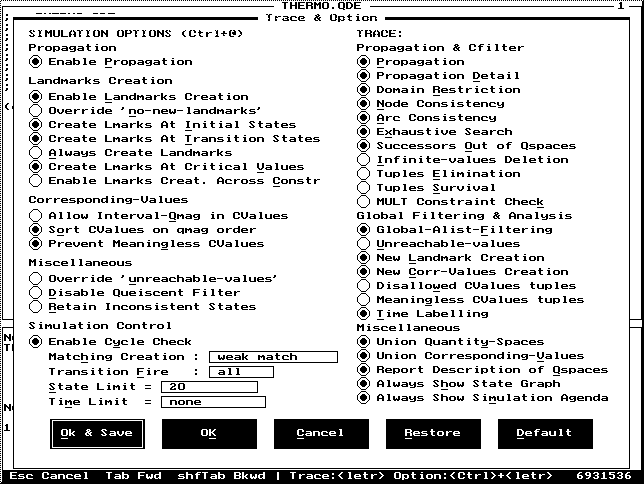
[Foreword] [Abstract] [SQSIM] [SQSIM in Action] [Download SQSIM]
Beginning with reading Prof. Benjamin Kuipers' book titled "Qualitative Reasoning: Modeling and Simulation with Incomplete Knowledge", I become interested in the area of qualitative reasoning. Therefore in my undergraduate final project in Informatics (Computer Science) Department at Institut Teknologi Bandung, Indonesia, I chose the topic qualitative simulation in the context of QSIM to be my thesis subject. I also successfully developed a qualitative simulator, named SQSIM, providing a subset of QSIM capability.
In this final project I learned and came to understand how to reason the physical word qualitatively and how to run qualitative simulation on a model of physical world. It is really an interesting area. (Remember when you were a little kid and once you were asked by your mother, "Go to the bathroom. See if the bathtub is already full." and then you saw that the bathtub was not full yet, you would never answered your mom, "Mom, the volume of water in the bathtub is one meter cubic.". You must have answered her "It's not full yet!").
This type of reasoning is hard to perform with current calculator-like computers. But now, with the birth of the concept of qualitative reasoning as an area of Artificial Intelligence, we are ready to use those compute-smart computers to reason as we, human, do reasoning with our world.
Credits
Qualitative reasoning is a novel subfield of Artificial Intelligence that makes inference and performs reasoning in the presence of incomplete knowledge. We would cope with the incomplete knowledge as we build a finite representation of continuous, infinite real-world mechanisms and as we do some inference on that representation. There are two primary tasks in qualitative reasoning, that is, model building and qualitative simulation of the model. Qualitative reasoning is based on qualitative description which is, in turn, built from qualitatively important information.
In this Final Project we study qualitative reasoning concept in the context of qualitative simulation used in the QSIM standard. We also design and implement SQSIM, a subset of QSIM. The qualitative model used in QSIM/SQSIM is Qualitative Differential Equation (QDE), which is an abstraction of ordinary differential equation.
QDE defines a set of qualitative variables and their quantity-spaces, a set of qualitative constraints, and a set of operating region transitions. A qualitative variable changes over time. The value of a qualitative variable consists of a landmark or an interval of two landmarks and a direction of value change. A landmark represents a qualitatively important value. A qualitative constraint represents qualitative and incomplete relations between variables. The most important constraint in qualitative reasoning is the monotonic function class. An operating region transition defines the boundary of QDE and allows the QDE simulation to switch to another QDE.
System state at any time is represented by a qualitative state built on a consistent set of qualitative values. All state values are consistent with the QDE constraints. A consistent state is built by a constraint value filtering process. An incomplete state would be more complete by running value propagation process in the network of constraints. A time sequence of states defines a qualitative behavior.
Given a QDE and an initial (and possibly
incomplete) state, SQSIM simulator would predict a set of
behaviors consistent with the QDE and the initial state.
Simulator applies some global
filters to eliminate inconsistent states and to make a
qualitative description of a state more specific. The set of predicted
behaviors contains qualitative behaviors that are abstractions of
the true behavior of real-world mechanisms modeled by QDE.
I built SQSIM by using Object Pascal language on the DOS platform.
SQSIM has the following subset capabilities of QSIM:
SQSIM succeeds in simulating the following qualitative models (QDEs) with various simulation options:

Fig 1. The opening screen of SQSIM

Fig 2. Simulation on Thermostat On-Off Controller

Fig 3. Simulation
Result Represented by Qualitative Status Description (the upper frame),
Qualitative Plot (the bottom
frame), and Interactive
Behavior Tree (the inset).

Fig 4. Simulation and Tracing Options Available in SQSIM